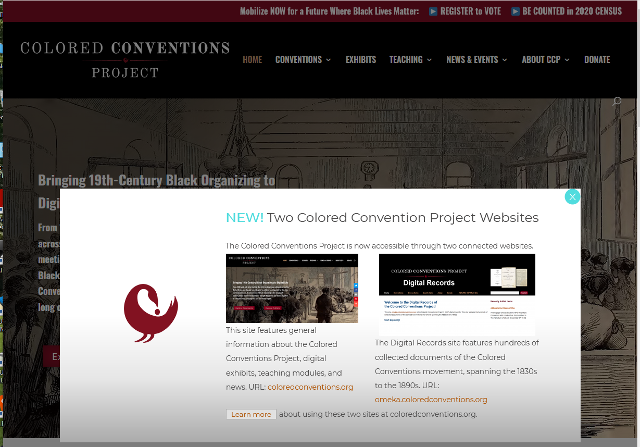
The international advocacy initiative the 4Humanities charged that makers within the digital realms have “ …a ‘special potential and responsibility to assist humanities advocacy’ because of [their] expertise in ‘making creative use of digital technology to advance humanities research and teaching’” (Gold). For this post, our focus is the Color Conventions Project (CCP), which defines itself as “a scholarly and community research project dedicated to bringing the seven decades-long histories of nineteenth-century Black organizing to digital life” (Introducing the Colored Conventions Project). This site was chosen because its makers made innovative use of a spectrum of technologies, offered users direct engagement, and explored a part of U.S. history about which I knew very little.
The site focus is a seventy-year span, from 1830 through the 1890s, when Black people organized across the U.S. and Canada in pursuit of suffrage and the legal recognition of their human rights. The mechanism they used was State and National political conventions. The main site breaks this history into a variety of exhibits that go beyond a specific event. For example, the section on Black women’s economic power details the important role Black women played in supporting these conventions, from housing travelers in their boarding houses, feeding the convention goers, and supporting the event with monetary contributions.
However, what makes the site come alive is the astounding collection of ephemera the site makers were able to collect, including the convention minutes from many of the events. These assets have been digitized, categorized, transcribed, and then given their own OMEKA database. There are dozens of photographs, cartoons, and renderings from the era. Moreover, many interactive maps help to focus the mind on how challenging it was for Black people to travel and assemble during this time. Nevertheless, for me, the ability to click a link … open a file …and to then be able to read the actual Minutes of the Fourth Annual Convention that was held in the Asbury Church in New York City on 12 June 1834 was profound and reminded me of something Professor Gold wrote in Digital Humanities: The Expanded Field:
Rather than requiring that the tool-building work of an ImagePlot or a Bookworm, to name two recent contributions to that domain, speak directly to their objects of analysis, we might explore how the creation and deployment of such tools perform distinct but equally valuable functions—functions that must be considered in relation to each other to achieve their maximal effect. (Gold)
It is that “relation to each other,” which the CCP does so well! The exhibits are given their historical context, but it is the primary source material that gives the site its soul. In Lisa Spiro’s thought-piece This Is Why We Fight”: Defining the Values of the Digital Humanities, the author asks that digital humanists “focus on a community that comes together around values such as openness and collaboration” (Spiro). Here the makers of the CCP also excel. On the site’s Principles page, the makers explain that “CCP seeks to enact collective organizing principles and values that were modeled by the Colored Conventions Movement” (Colored Convention Project Principles). The fact they chose to model this modern endeavor using the same principles and values of the people who were the objects of their scholarship has a satisfying symmetry and shows this reader their respect for those now long dead.
Finally, the makers of the CCP project do not limit their scholarship to the Academy; instead, they actively recruit any user to submit materials they may have found. This is a critical step for scholars who do not want to risk falling into the trap of only talking to each other. This is also consistent with an observation Professors Gold and Klein made in A DH That Matters, where they wrote: “the digital humanities has always seen itself as a field that engages the world beyond the academy—through its orientation toward the public in its scholarship, pedagogy, and service” (Gold and Klein).
Bibliography
Colored Convention Project Principles. n.d. Website. 31 Aug 2020. <https://coloredconventions.org/about/principles/>.
Gold, Matthew K., and Lauren F. Klein. “Introduction. A DH That Matters.” Debates in the Digital Humanities 2019. Minneapolis: University of Minnesota Press, 2019. eBook.<https://dhdebates.gc.cuny.edu/read/untitled-f2acf72c-a469-49d8-be35-67f9ac1e3a60/section/0cd11777-7d1b-4f2c-8fdf-4704e827c2c2#intro>.
Gold, Matthew K. “Introduction. Digital Humanities: The Expanded Field.” Gold, Matthew K., and Lauren F. Klein. Debates in the Digital Humanities 2016. Minneapolis: University of Minnesota Press, 2016. eBook. <https://dhdebates.gc.cuny.edu/read/untitled/section/14b686b2-bdda-417f-b603-96ae8fbbfd0f#intro>.
Gold, Matthew K. “Introduction: The Digital Humanities Moment.” Gold, Matthew K. Debates in the Digital Humanities. Ed. Matthew K. Gold. 1. Vol. 1. Minneapolis: University of Minnesota Press, 2012. eBook. <https://dhdebates.gc.cuny.edu/read/untitled-88c11800-9446-469b-a3be-3fdb36bfbd1e/section/fcd2121c-0507-441b-8a01-dc35b>.
Introducing the Colored Conventions Project. n.d. Website. 28 Aug 2020. <https://coloredconventions.org/about/>.
Spiro, Lisa. “This Is Why We Fight”: Defining the Values of the Digital Humanities.” Debates in the Digital Humanities. Ed. Matthew K. Gold. Minneapolis: University of Minnesota Press, 2012. eBook. <https://dhdebates.gc.cuny.edu/read/untitled-88c11800-9446-469b-a3be-3fdb36bfbd1e/section/9e014167-c688-43ab-8b12-0f6746095335#ch03>.



